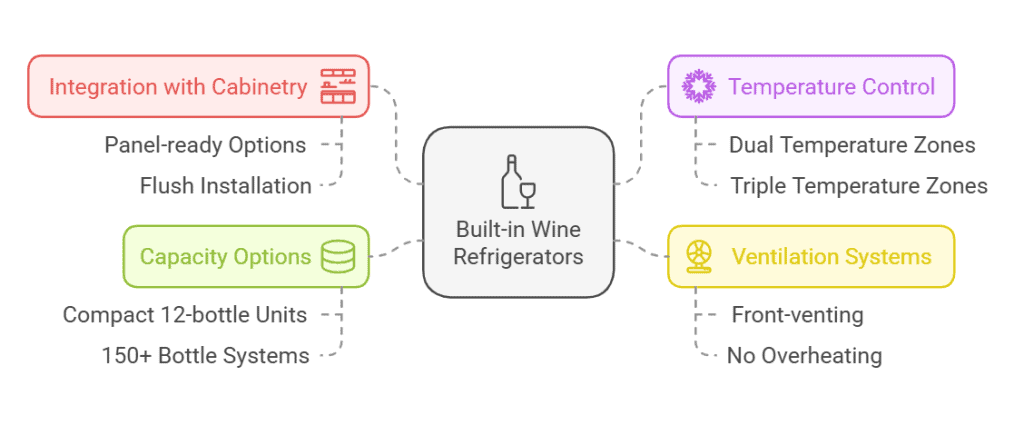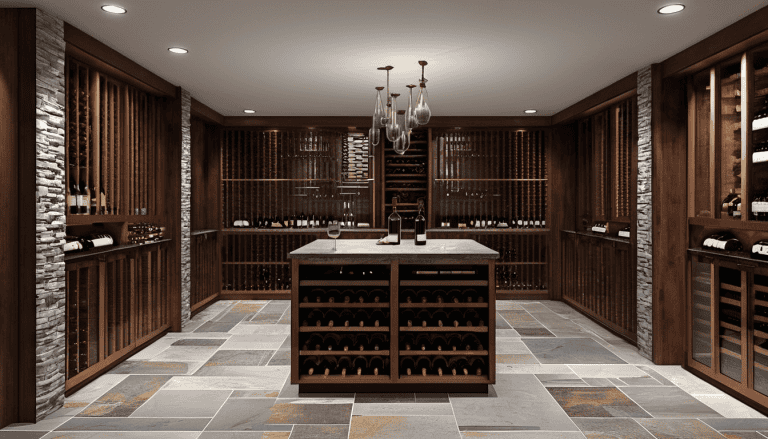Did you know that improper wine storage can reduce a wine’s value by up to 50%?
As a wine enthusiast for many years, I’ve seen countless collectors make the switch to built-in wine refrigerators to protect their valuable collections. These sophisticated appliances are becoming increasingly popular, with the global wine cabinet market expected to reach $2.5 billion by 2027!
Today, I’ll guide you through everything you need to know about built-in wine refrigerators, helping you make an informed decision for your wine storage needs.
Welcome to Didi Somm, and Cheers!
Important Notice: The information in this article is for general and public information purposes only. It solely reflects Didi Somm’s or his Staff’s opinion, and no responsibility can be assumed for errors or omissions in the service’s contents. For details, please check the Disclaimer at the bottom of the homepage.

Key Takeaways
- Built-in wine refrigerators offer precise temperature control and seamless integration with kitchen cabinetry
- Professional installation is recommended to ensure proper ventilation and optimal performance
- Costs typically range from $500 to $5,000+ depending on size and features
- Regular maintenance extends lifespan and ensures consistent temperature control
- Consider capacity needs, available space, and existing kitchen design before purchasing
Understanding Built-in Wine Refrigerators
After spending over 15 years as a wine collector and consultant, I’ve seen firsthand how built-in wine refrigerators have revolutionized home wine storage.
Let me tell you, these aren’t your standard kitchen appliances! Built-in wine refrigerators are specialized units designed to integrate seamlessly into your cabinetry while maintaining precise temperature control for your wine collection.
Unlike their freestanding counterparts, which can be placed anywhere with proper ventilation, built-in models feature front-venting systems that allow them to be installed flush with your cabinetry without overheating.
I remember when I first discovered the difference – I had mistakenly installed a freestanding unit under my counter, and boy, was that a costly lesson in proper ventilation! Most built-in units offer dual or even triple temperature zones, ranging from 40°F to 65°F, perfect for storing different wine varieties at their optimal temperatures.
You’ll find models ranging from compact 12-bottle units perfect for urban apartments to impressive 150+ bottle capacity systems for serious collectors. What really sets these units apart is their integration potential – with panel-ready options that can match your existing cabinetry, they’re practically invisible until you open them up to grab that perfect bottle.

Advantages of Built-in Wine Refrigerators
I’ll never forget the moment I upgraded from my old freestanding wine cooler to a built-in model – it was like going from a flip phone to a smartphone! The advantages are seriously game-changing.
First off, the seamless integration with my kitchen cabinetry transformed the entire space. No more awkward appliance jutting out or collecting dust behind it! The temperature control is incredibly precise, typically within 1°F, which I learned is crucial after losing a few precious bottles to temperature fluctuations in my old unit.
These babies are energy efficiency champions, too – my electricity bill actually went down despite the upgrade. The UV-protected glass doors are a lifesaver; I used to worry about light exposure from my kitchen windows, but now my wines are totally protected.
Here’s something most people don’t realize: Built-in units often have better humidity control systems than freestanding models. I maintain a perfect 70% humidity level, which keeps those corks nice and moist. Plus, the front-venting design means you can maximize every inch of space in your kitchen layout.
Trust me, once you experience the whisper-quiet operation and the joy of having your wine collection perfectly integrated into your kitchen design, there’s no going back.
Potential Drawbacks to Consider
Let’s keep it real here – built-in wine refrigerators aren’t all roses and champagne.
When I first looked into getting one, the price tag nearly made me spit out my Cabernet! These units typically start around $500 and can easily climb past $5,000 for larger, feature-rich models.
I learned the hard way that installation isn’t a DIY weekend project either – you’ll need a professional to ensure proper ventilation and electrical setup, which adds to the cost. Another thing that caught me off guard was the permanence factor.
Unlike freestanding units, once these are installed, they’re pretty much there to stay. Moving them requires significant effort and potentially new cabinetry work. Size constraints can be tricky, too; I had to compromise on bottle capacity because of my cabinet dimensions.
The ventilation requirements are no joke – you need specific clearances for the front-venting system to work properly, which might affect your kitchen layout more than you’d expect.
And let’s talk about repairs – when something goes wrong, you can’t just slide it out and take a look. Most repairs require a professional service call, which can be both costly and time-consuming.
Comparison Table – Pros & Cons of Built-in Wine Refrigerators
| Aspect | Pros | Cons |
|---|---|---|
| Design & Integration | Seamless integration with kitchen cabinetry, enhancing the overall aesthetic. | Permanence of installation – relocating requires significant effort and potential cabinetry work. |
| Temperature Precision | Precise temperature control within 1°F, reducing risk of wine spoilage. | None specifically noted. |
| Energy Efficiency | Highly energy-efficient, often leading to lower electricity bills. | High initial cost, starting at $1,000 and climbing with larger or advanced models. |
| UV & Humidity Protection | UV-protected glass doors and superior humidity control (70%) to maintain wine quality. | None specifically noted. |
| Space Utilization | Front-venting design allows maximum use of kitchen space. | Ventilation requirements might affect kitchen layout and need specific clearances. |
| Operation | Whisper-quiet operation ensures minimal noise disruption. | Repairs often require professional service calls, which can be costly and time-consuming. |
| Installation | Professional look and feel once installed. | Requires professional installation, adding to the overall cost. |
| Bottle Capacity | Customizable to fit within cabinetry dimensions. | Size constraints may limit bottle capacity due to cabinet dimensions. |
Installation Requirements and Process
Having overseen dozens of wine refrigerator installations, I can tell you that proper installation is absolutely crucial for long-term performance.
Ventilation Requirements
The ventilation requirements are specific and non-negotiable – you typically need at least 1/4 inch clearance on both sides and 1-2 inches at the back, plus that all-important front ventilation space. You’ll want a dedicated 15-amp circuit for your unit; I learned this lesson after blowing a few fuses when sharing circuits.
Standard Dimensions
Standard dimensions for built-in units typically range from 15 to 24 inches wide and 32 to 34 inches in height, but always measure twice! The installation process itself takes about 2-4 hours with a professional. They’ll need to level the unit perfectly (even a slight tilt can affect the door seal), ensure proper electrical connections, and set up any custom panels.
Professional Installation
I’ve seen enough DIY attempts gone wrong to strongly recommend professional installation – one client tried to save money by doing it themselves and ended up with a $3,000 repair bill due to improper ventilation. The pros will come equipped with everything needed: level, shims, screwdrivers, drill, multimeter, and those specialized tools for handling custom panels.
Affiliate Disclaimer: This page may include Affiliate links, meaning that we get a commission if you decide to purchase through this site at no extra cost to you. Please read our Disclaimer for your info.
Choosing the Right Built-in Wine Refrigerator
After helping countless friends select their perfect wine storage solution, I’ve developed a foolproof approach to choosing the right built-in wine refrigerator.
Collection Size
Start by being honest about your collection size – and don’t forget to account for growth! I always recommend choosing a unit with at least 20% more capacity than you currently need. Precise measurements are crucial; I’ve seen too many people fall in love with a model only to discover it won’t fit their space.
Temperature Zones
Temperature zones are another key consideration – if you enjoy both reds and whites, a dual-zone unit is non-negotiable. I spent weeks comparing different brands and models before making my choice, focusing on reliability ratings and user reviews.
Warranty
The warranty is super important, too – look for coverage that includes both parts and labor for at least 1-2 years.
Energy Efficiency
Energy efficiency might seem like a minor detail, but it can save you hundreds over the unit’s lifetime.
I always tell my clients to consider the cost-per-bottle capacity rather than just the overall price. A $2,000 unit that holds 100 bottles might be a better value than a $1,200 unit that holds 40.

Maintenance and Care Tips
Over my years of working with wine storage systems, I’ve developed a maintenance routine that keeps these units running like clockwork.
Regular cleaning is essential – I wipe down the interior monthly with a solution of mild soap and water, never harsh chemicals. The door seals need special attention; I check them quarterly for any signs of wear or cracking and clean them with a soft cloth to maintain their integrity.
Temperature monitoring is crucial – I keep a separate thermometer inside as a backup, checking it weekly against the unit’s display. Your filter replacement schedule depends on your model, but I typically change mine every 6-12 months.
When it comes to troubleshooting, start with the basics: check the door seal, clean the front vent, and ensure proper temperature settings before calling for service. Speaking of service, I highly recommend scheduling annual maintenance checks with a certified technician – they can spot potential issues before they become problems.
One of my favorite energy-saving tips is to minimize door openings; I keep an inventory list outside the unit so I know exactly where each bottle is located. Trust me, these simple maintenance steps can add years to your unit’s life!
Checklist – Maintenance and Care Tips
| Task | Frequency | Details |
|---|---|---|
| Minimize Door Openings | Ongoing | Use an inventory list outside the unit to reduce door use and save energy. |
| Monitor Temperature | Weekly | Use a backup thermometer and compare it with the unit’s display. |
| Clean The Interior | Monthly | Use mild soap and water; avoid harsh chemicals. |
| Inspect And Clean Door Seals | Quarterly | Check for wear or cracks and clean with a soft cloth to maintain integrity. |
| Replace Filters | Every 6-12 months | Follow the model-specific schedule for filter replacement. |
| Schedule Professional Service | Annually | Have a certified technician perform a maintenance check to catch potential issues early. |
| Troubleshoot Issues | As Needed | Check door seal, clean front vent, and verify temperature settings before calling for service. |
FAQ – Built-In Wine Refrigerators
- How much does a built-in wine refrigerator cost? Answer: Built-in wine refrigerators typically range from $500 to $5,000+, depending on size, features, and brand quality.
- What’s the difference between freestanding built-in wine refrigerators? Answer: Built-in units are designed with front-venting systems for undercounter installation, while freestanding units require space around them for ventilation.
- Do I need a professional to install a built-in wine refrigerator? Answer: While not always required, professional installation is highly recommended to ensure proper ventilation, electrical connections, and optimal performance.
- How many bottles can a built-in wine refrigerator hold? Answer: Capacity varies widely, ranging from 12 bottles in compact units to 150+ bottles in larger models.
- What temperature should I set for my wine refrigerator? Answer: Red wines typically need 55-65°F, while white wines require 45-55°F. Dual-zone units can accommodate both simultaneously.
- How long do built-in wine refrigerators last? Answer: With proper maintenance, built-in wine refrigerators typically last 10-15 years.
- Can I install a built-in wine refrigerator myself? Answer: While possible, DIY installation risks improper ventilation and void warranty coverage. Professional installation is recommended.
- What maintenance does a built-in wine refrigerator require? Answer: Regular cleaning, door seal checks, temperature monitoring, and annual professional inspection are recommended.
- Do built-in wine refrigerators need a dedicated circuit? Answer: Yes, most built-in wine refrigerators require a dedicated 15-amp circuit for optimal performance and safety.
- Can built-in wine refrigerators be installed outdoors? Answer: Only specific models designed for outdoor use should be installed outside, as standard units can’t handle extreme temperatures.
- How much ventilation space is needed for a built-in wine refrigerator? Answer: Typically, you need 1/4 inch on both sides, 1-2 inches at the back, and proper front ventilation according to manufacturer specifications.
- Are built-in wine refrigerators energy efficient? Answer: Modern built-in wine refrigerators are generally energy efficient, with many models being Energy Star certified.
- Can I store other beverages in my wine refrigerator? Answer: While possible, wine refrigerators are specifically designed for wine storage temperatures and shouldn’t replace regular refrigerators.
- What should I look for in a warranty? Answer: Look for warranties covering both parts and labor for at least 1-2 years, with additional coverage for the sealed system.
- How noisy are built-in wine refrigerators? Answer: Quality built-in wine refrigerators typically operate at 35-45 decibels, similar to a quiet library.
Conclusion
Built-in wine refrigerators represent a significant investment in both your wine collection and home value.
While they require careful consideration of installation requirements and initial costs, the benefits of proper wine storage, seamless integration with your kitchen design, and precise temperature control make them an excellent choice for serious wine enthusiasts.
By following the installation tips and maintenance guidelines outlined above, you can ensure your built-in wine refrigerator provides optimal storage conditions for your collection for years to come.
Good luck with your built-in wine refrigerator, and Cheers!
For your reference, the latest articles by Didi Somm include:
- How To Choose The Perfect Wine Fridge: A Beginner’s Guide 2025
- Wine Fridge Vs Regular Refrigerator – Best Expert Guide
- Top 5 Dual-Zone Wine Refrigerators: Best Expert Guide for You
- Best Energy-Efficient Wine Fridges: Get Expert Tips And Advice
- How to Clean Wine Refrigerator: Best Expert Guide
- Best Wine Fridge Temperature Settings: All You Need To Know
Important Notice: The information in this article is for general and public information purposes only. It solely reflects Didi Somm’s or his Staff’s opinion, and no responsibility can be assumed for errors or omissions in the service’s contents. For details, please check the Disclaimer at the bottom of the homepage.




